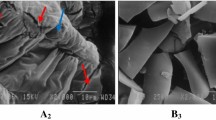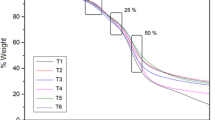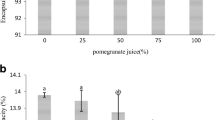Abstract
The acidified ethanol extract of pomegranate (Punica granatum L.) peel bioactive compounds was freeze-dried and encapsulated using a combination of maltodextrin (MDX 5, 10, and 15%) with calcium alginate (0.1%) with a weight ratio (w/w) of 1:5 (extract/wall material). The effects of various parameters on pomegranate peel extraction (POPx) and POPx-encapsulated powder were analyzed on bioactive components, physicochemical, morphological properties, and storage stability. The results revealed that process yield was positively influenced by increasing MDX concentration, due to the increase on mixture content. Encapsulated powder with 15% MDX had the highest total phenolic compounds (TPC, 73.1 mg GA/kg), the total anthocyanin content (TAC, 40.2 mg c3g/kg dmp and antioxidant capacity by FRAP, 405 (Fe2+, μmol/l)), the DPPH assay (RSA, 65.1%), the lowest IC50, 0.56 ± 0.02 mg/ml, and the lowest glass transition temperature indicating that the highest antioxidant capacity among other wall materials. In respect to morphology, the particles of encapsulated powders with high concentration of MDX were larger and smoother. Stability and half-life of encapsulated powders were measured from 42 days of storage study at 4 °C and 25 °C, and 52 and 75% relative humidity. Storage tests revealed first-order degradation kinetics for anthocyanin. The TAC of the PoPx-microencapsulated powders with wall material of 15% and control decreased by 18% and 33%, respectively, after 42 days storage at 4 °C, while at the storage temperature of 25 °C, the decreases were in the order of 24% and 38%, respectively, over the same period of time. The highest anthocyanin content was observed in the freeze-dried MDX 15%-encapsulated powder at 4 °C storage temperature and 75% relative humidity with a half-life (t1/2) of 115 days, and the reaction rate constant (k) of 0.64 × 10−2 min−1.



Similar content being viewed by others
Abbreviations
- Y:
-
Yield
- E:
-
Efficiency
- TPC:
-
Total phenolic compounds
- RSA:
-
Radical scavenging activity
- FRAP:
-
Ferric reducing antioxidant power
- TAC:
-
Total anthocyanin content
- IC50 :
-
The concentration of extract required to scavenge 50% of 2, 2-diphenyl-1-picrylhydrazyl free radical
- POP:
-
Pomegranate peel
- POPx:
-
Pomegranate peel extract
- Tg:
-
Glass transition temperature
- MDX:
-
Maltodextrin
References
Ahmed, M., Akter, M. S., Lee, J. C., & Eun, G. B. (2010). Encapsulation by spray drying of bioactive components, physicochemical and morphological properties from purple sweet potato. LWT-Food Science and Technology, 43(9), 1307–1312.
Bakowska-Barczak, A. M., & Kolodziejczyk, P. P. (2011). Black currant polyphenols: their storage stability and microencapsulation. Industrial Crops and Products, 34(2), 1301–1309.
Benzie, I. F. F., & Strain, J. J. (1996). The ferric reducing ability of plasma (FRAP) as a measure of antioxidant power: the FRAP assay. Analytical Biochemistry, 239(1), 70–76.
Brand-Williams, W., Cuvelier, M. E., & Berset, C. (1995). Use of a free radical method to evaluate antioxidant activity. LWT-Food Science and Technology, 28(1), 25–30.
Cai, Y. Z., & Corke, H. (2000). Production and properties of spray-dried Amaranthus Betacyanin pigments. Journal of Food Science, 65(7), 1248–1252.
Cemeroglu, B., Velioglu, S., & Isik, S. (1994). Degradation kinetics of anthocyanins in sour cherry juice and concentrate. Journal of Food Science, 59(6), 1216–1218.
Da Silva Carvalho, A. G., da Costa Machado, M. T., da Silva, V. M., Sartoratto, A., Rodrigues, R. A. F., & Hubinger, M. D. (2016). Physical properties and morphology of spray dried microparticles containing anthocyanins of jussara (Euterpe edulis Martius) extract. Powder Technology, 294, 421–428.
Deladino, L., Pablo, S. A., Alba, S. N., & Miriam, N. M. (2007). Encapsulation of natural antioxidants extracted from Ilex paraguariensis. Carbohydrate Polymers, 71(1), 126–134.
Desai, K., Goud, H., & Hyun, J. P. (2005). Recent developments in microencapsulation of food ingredients. Drying Technology, 23(7), 1361–1394.
Ersus, S., & Yurdagel, U. (2007). Microencapsulation of anthocyanin pigments of black carrot (Daucus carota L.) by spray drier. Journal of Food Engineering, 80(3), 805–812.
Fang, Z., & Bhandari, B. (2011). Effect of spray drying and storage on the stability of bayberry polyphenols. Food Chemistry, 129(3), 1139–1147.
Fang, Z., & Bhandari, B. (2012). Comparing the efficiency of protein and maltodextrin on spray drying of bayberry juice. Food Research International, 48(2), 478–483.
Flores, F. P., Singh, R. K., & Kong, F. (2014). Physical and storage properties of spray-dried blueberry pomace extract with whey protein isolate as wall material. Journal of Food Engineering, 137, 1–6.
Gharsallaoui, A., Roudaut, G., Chambin, O., Voilley, A., & Saurel, R. (2007). Applications of spray-drying in microencapsulation of food ingredients: an overview. Food Research International, 40(9), 1107–1121.
Giusti, M. M., & Wrolstad, R. E. (2001). In R. E. Wrolstad (Ed.), Current protocols in food analytical chemistry (pp. 1–13). New York: John Wiley & Sons.
Gözlekçi, S., Saraçoğlu, O., Ebru Onursal, E., & Mustafa Özgen, M. (2011). Total phenolic distribution of juice, peel, and seed extracts of four pomegranate cultivars. Pharmacognosy Magazine, 7(26), 161–164.
Gradinarua, G., Biliaderisb, C. G., Kallithrakac, S., Kefalasa, P., & Garcia-Viguerad, C. (2003). Thermal stability of Hibiscus sabdariffa L. anthocyanins in solution and in solid state: effects of copigmentation and glass transition. Food Chemistry, 83(3), 423–436.
Hager, T. J., Howard, L. R., & Prior, R. L. (2008). Processing and storage effects on monomeric anthocyanins, percent polymeric color, and antioxidant capacity of processed blackberry products. Journal of Agricultural and Food Chemistry, 56(3), 689–695.
Hamedi, F., Mohebbi, M., Shahidi, F., & Azarpazhooh, E. (2018). Ultrasound-assisted osmotic treatment of model food impregnated with pomegranate peel phenolic compounds: mass transfer, texture, and phenolic evaluations. Food and Bioprocess Technology, 11(5), 1060–1074.
Iversen, C. K. (1999). Black currant nectar: effect of processing and storage on anthocyanin and ascorbic acid content. Journal of Food Science, 64(1), 37–41.
Jafari, S. M., & Mahdavi-Khazaei, K. (2016). Microencapsulation of saffron petal anthocyanins with cress seed gum compared with Arabic gum through freeze drying. Carbohydrate Polymers, 140, 20–25.
Jalil, R., & Nixon, J. R. (1990). Microencapsulation using poly(DL-lactic acid) II: effect of polymer molecular weight on the microcapsule properties. Journal of Microencapsulation, 7(2), 245–254.
Kaderides, K., Goulaa, M. A., & Adamopoulosb, K. G. (2015). A process for turning pomegranate peels into a valuable food ingredient using ultrasound-assisted extraction and encapsulation Author links open overlay panel. Innovative Food Science & Emerging Technologies, 31, 204–215.
Kanatt, S. R., Chander, R., & Sharma, A. (2010). Antioxidant and antimicrobial activity of pomegranate peel extract improves the shelf life of chicken products. International Journal of Food Science and Technology, 45(2), 216–222.
Karimi, M., Fathi, M., Sheykholeslam, Z., Sahraiyan, B., & Naghipoor, F. (2012). Effect of different processing parameters on quality factors and image texture features of bread. Journal of Bioprocessing and Biotechniques, 2(5), 1–7.
Kaushik, V., & Roos, Y. H. (2007). Limonene encapsulation in freeze-drying of gum Arabic-sucrose-gelatin systems. LWT, Food Science and Technology, 40(8), 1381–1391.
Khazaei, K. M., Jafari, S., Ghorbani, M., & Kakhki, A. H. (2014). Application of maltodextrin and gum Arabic in microencapsulation of saffron petal’s anthocyanins and evaluating their storage stability and color. Carbohydrate Polymers, 105, 57–62.
Liu, L., Sun, Y., Laura, T., Liang, X., Ye, H., & Zeng, X. (2009). Determination of polyphenolic content and antioxidant activity of kudingcha made from Ilex Kudingcha C.J. Tseng. Food Chemistry, 112(1), 35–41.
Mahdavi, S. A., Jafari, S. M., Ghorbani, M., & Assadpoor, E. (2014). Spray-drying microencapsulation of anthocyanins by natural biopolymers: a review. Drying Technology, 32(5), 509–518.
Mirdehghan, S. H., & Rahemi, H. (2007). Seasonal changes of mineral nutrients and phenolics in pomegranate (Punica granatum L) fruit. HortScience, 111, 120–127.
Nayak, C. A., & Rastogi, K. N. (2010). Effect of selected additives on microencapsulation of anthocyanin by spray drying. Drying Technology, 28(12), 1396–1404.
Opara, L. U., Al-Ani, M. R., & Al-Shuaibi, Y. S. (2009). Physico-chemical properties, vitamin C content, and antimicrobial properties of pomegranate fruit (Punica granatum L.). Food and Bioprocess Technology, 2(3), 315–321.
Pan, Z., Qu, W., Ma, H., Atungulu, G. G., & McHugh, T. H. (2011). Continuous and pulsed ultrasound-assisted extractions of antioxidants from pomegranate peel. Ultrasonics Sonochemistry, 18(5), 1249–1257.
Parrarud, S., & Pranee, A. (2010). Microencapsulation of Zn-chlorophyll pigment from pandan leaf by spray drying and its characteristic. International Food Research Journal, 17, 1031–1042.
Prakash, A., Mathur, K., Vishwakarma, A., Vuppu, S., & Mishra, B. (2013). Comparative assay of antioxidant and antibacterial properties of Indian culinary seasonal fruit peel extracts obtained from Vellore, Tamilnadu. International Journal of Pharmaceutical Sciences Review and Research, 19(1), 131–135.
Reyes, L. F., & Cisneros-Zevallos, L. (2007). Degradation kinetics and colour of anthocyanins in aqueous extracts of purple-and red-flesh potatoes (Solanum tuberosum L.). Food Chemistry, 100(3), 885–894.
Robert, P., Gorena, T., Romero, N., Sepulveda, E., Chavez, J., & Saenz, C. (2010). Encapsulation of polyphenols and anthocyanins from pomegranate (Punica granatum) by spray drying. International Journal of Food Science & Technology, 45(7), 1386–1394.
Santos, D. T., & Meireles, M. A. A. (2011). Optimization of bioactive compounds extraction from jabuticaba (Myrciaria cauliflora) skins assisted by high pressure CO2. Innovative Food Science and Emerging Technologies, 12(3), 398–406.
Selim, K., Tsimidou, M., & Biliaderis, C. G. (2000). Kinetic studies of degradation of saffron carotenoids encapsulated amorphous polymer matrices. Food Chemistry, 71(2), 199–206.
Shabtay, A., Eitam, H., Tadmor, Y., Orlov, A., Meir, A., Weinberg, P., Weinberg, Z. G., Chen, Y., Brosh, A., Izhaki, I., & Kerem, Z. (2008). Nutritive and antioxidative potential of fresh and stored pomegranate industrial byproduct as a novel beef cattle feed. Agricultural and Food Chemistry, 56(21), 10063–10070.
Silva, S., Costa, E. M., Calhau, C., Morais, R. M., & Pintado, M. E. (2017). Anthocyanin extraction from plant tissues: a review. Critical Reviews in Food Science and Nutrition, 57(14), 3072–3083.
Singleton, V. L., Orthofer, R., & Lamuela-Raventos, R. M. (1999). Analysis of total polyphenols and other oxidation substrates and antioxidants by means of folin–ciocalteu reagent. Methods in Enzymology, 299, 152–178.
Tabaraki, R., Heidarizadi, E., & Benvidi, A. (2012). Optimization of ultrasonic assisted extraction of pomegranate (Punica granatum L.) peel antioxidants by response surface methodology. Separation and Purification Technology, 98, 16–23.
Tonon, R. V., Brabet, C., & Hubinger, M. D. (2008). Influence of process conditions on the physicochemical properties of açai (Euterpe oleraceae Mart.) powder produced by spray drying. Journal of Food Engineering, 88(3), 411–418.
Tonon, R. V., Brabet, C., & Hubinger, M. D. (2010). Anthocyanin stability and antioxidant activity of spray-dried acai (Euterpe oleracea Mart.) juice produced with different carrier agents. Food Research International, 43(3), 907–914.
Wang, W. D., & Xu, S. Y. (2007). Degradation kinetics of anthocyanins in blackberry juice and concentrate. Journal of Food Engineering, 82(3), 271–275.
Funding
This work is financially supported by the Iran National Scientific Foundation (INSF) and Agricultural Engineering Research Institute (AERI).
Author information
Authors and Affiliations
Corresponding author
Ethics declarations
Conflict of Interest
The authors declare that they have no conflict of interest.
Rights and permissions
About this article
Cite this article
Azarpazhooh, E., Sharayei, P., Zomorodi, S. et al. Physicochemical and Phytochemical Characterization and Storage Stability of Freeze-dried Encapsulated Pomegranate Peel Anthocyanin and In Vitro Evaluation of Its Antioxidant Activity. Food Bioprocess Technol 12, 199–210 (2019). https://doi.org/10.1007/s11947-018-2195-1
Received:
Accepted:
Published:
Issue Date:
DOI: https://doi.org/10.1007/s11947-018-2195-1




